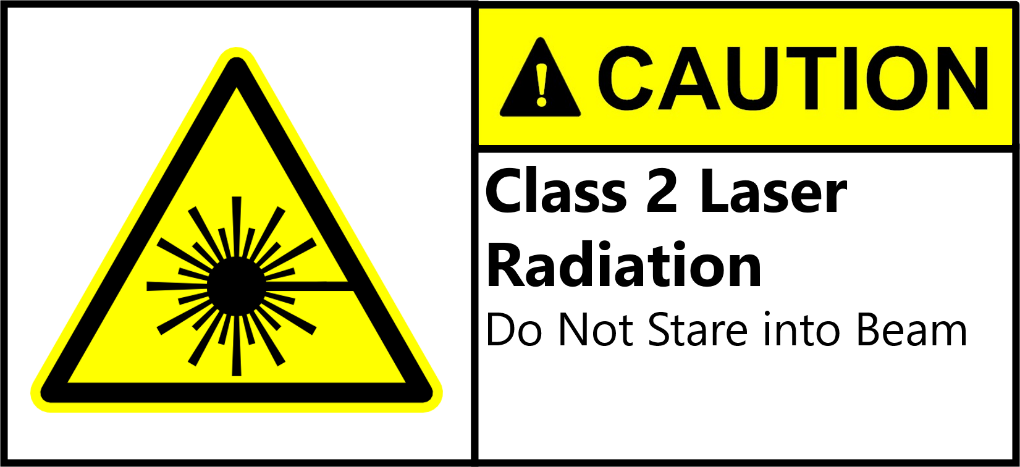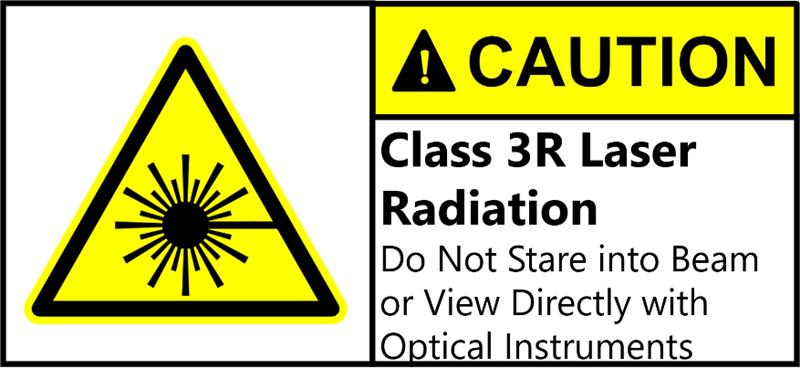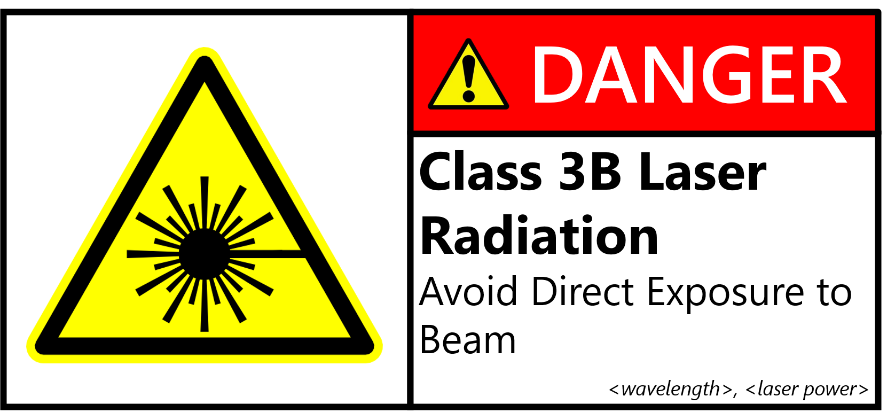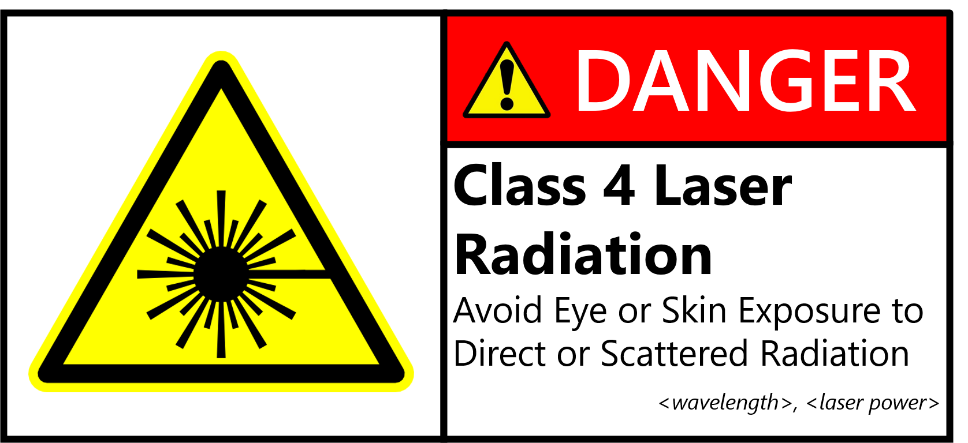The hazards associated with laser use vary depending upon radiant power emitted by the laser. Control selection will be based on the classification of the specific laser and the nature (power and wavelength) of its emitted radiation, as appropriate.
5.1 Laser Cutters
The requirements for operation of laser cutters are satisfied by completion of initial training; as such, the full contents of this document may not be applicable to personnel only using laser cutters.
5.2 General Precautions and Requirements for all Lasers
Laser beams may not be intentionally directed at the head or face of another person.
ANSI/IEC Laser Safety approved signs and labels are provided by the Lab Manager or equipment owner and must be conspicuously displayed in locations where they best serve to warn onlookers. Laser controlled areas must be posted with the appropriate warning signs at the entryway(s) and if necessary, within the laser-controlled area.
All lasers or laser systems (except Class 1) must have appropriate warning labels affixed to a conspicuous place on both the housing and the control panel (if separated by more than 2 meters).
All laser protective windows must be labeled with the optical density and wavelength(s) for which protection is afforded, the threshold limit and exposure time for which the limit applies, and the conditions under which protection is afforded.
All laser protective barriers must be labeled with the barrier threshold limit and exposure time for which the limit applies, and beam exposure conditions under which protection is afforded. This includes barrier curtains used to enclose a laser control area. Ordinary fabric may not provide adequate protection from laser radiation and may not have fire resistance needed for some Class 4 laser operations.
The LSO must approve plans to remove protective shielding to ensure appropriate hazard controls are established; removal of protective housing or system modification can dramatically increase the risk of injury and can also increase a laser’s classification and associated safe work practices.
Prototype devices may be used prior to receiving final classification by the manufacturer. When using off-the-shelf products, use controls in accordance with laser class determined by the manufacturer. For assemblies where the laser is part of a larger device, the laser class must be determined by an authorized third party.
All laser beams must be terminated by a beam stop at the end of their useful paths by a material that is non-reflective. For Class 4 lasers, the beam stop must be fire resistant as well.
For open-beam lasers, additional considerations must be made, including:
Laser radiation levels in excess of the MPE must not pass the boundaries of the control area.
All windows, doorways, open portals, and other openings through which radiation might escape from a laser control area must be covered or shielded in such a manner as to preclude the transmission of laser radiation.
Where feasible, the laser user is required to keep all laser beams within the operating field, on the optical table, or within the experimental envelope at all times. To maintain this control, it is essential to be aware of all beams, including stray beams and/or reflections, and to terminate them with beam stops at the end of their useful paths.
When a beam traverses to other tables or across aisles, the beam must be enclosed or the access to the aisle must be blocked to prevent personnel from exposure to the beam.
Lasers should be mounted so that the beam path is not at eye level for standing or seated personnel.
Laser protective eyewear of adequate optical density (OD) and threshold limit for the beams under manipulation must be provided and worn at any point where laser exposure could exceed the maximum permissible exposure (MPE). Laser eye protection should be compliant with ANSI Z136-1 and inspected periodically to ensure that it is in good condition.
Laser users must report any non-exposure laser incident on site, no matter how minimal, to the Lab Manager and Equipment owner. The Site Laser Safety Officer or Microsoft OHS must be notified within 24 hours of an incident. Incident investigation is required for all laser-related incidents, even if there are no injuries or property damage. Examples of incidents are someone entering laser control area without adequate protections; any known or suspected exposure of people to Class 3R, Class 3B, or Class 4 laser radiation; failure of an interlock; and vision disturbances – even without known direct exposure.
| Laser Class | Definition and Requirements |
| Class 1 | Class 1 Laser System: Considered to be incapable of producing exposure conditions during normal operation unless the beam is viewed with an optical instrument such as an eye-loupe or a telescope.
Training: N/A
Signage: N/A
Control Area Requirements: N/A
PPE: N/A
Risk Assessment: N/A
SOP Required: N/A
|
| Class 2 | Class 2 Laser System: Emits radiation in the visible portion of the spectrum (400nm-700nm).
Class 2M Laser System: Emits in the visible portion of the spectrum (400nm-700nm). Class 2M is potentially hazardous if viewed with certain optical aids.
Training: N/A
Signage: Class 2 lasers and laser systems, “Laser Radiation – Do Not Stare into Beam"
Control Area Requirements: N/A
PPE: ANSI rated safety glasses
Risk Assessment: N/A
SOP Required: N/A
|
| Class 3 | Class 3R laser systems are potentially hazardous under some direct and specular reflection viewing conditions if the eye is appropriately focused and stable, but the probability of an actual injury is small. This laser will not post either fire hazard or diffuse-reflection hazard.
Class 3B laser system may be hazardous under direct and specular reflection viewing conditions, but is normally not a diffuse-reflection or fire hazard
Training:
All employees who use Class 3R or Class 3B lasers must complete the appropriate Microsoft Laser Safety training course. The course is available on-line.
Signage:
The areas using Class 3R or Class 3B, lasers must be posted with appropriate warning signs that indicate the nature of the hazard. The wording on the signs must conform to ANSI Z136.1 and will be specified by Microsoft OHS. Such signs must be posted at all entrances to the laser control area during the time the active beam is in use. In addition, an SOP approved by the LSO must be posted in a location readily available to the user.


Control Area Requirements:
Class 3B lasers must be operated only in designated laser control areas, as approved by the LSO. The purpose of laser control areas is to confine laser hazards to well-defined spaces that are under the control of the laser user, thereby preventing injury to those visiting and working nearby.
All Class 3R and 3B lasers must be operated under the direct supervision or controls of an authorized operator at all times. This operator must terminate the laser use in the event of an equipment malfunction or unsafe use. Class 3R and 3B lasers must not be left unattended when operating.
Only personnel who have been authorized by the Lab Manager may operate a Class 3R or Class 3B, laser. Personnel are considered authorized upon completing the Microsoft Laser Safety training, completing orientation to the specific laser, acknowledging review of the SOP, and obtaining permission from the Lab Manager. The Lab Manager may also stipulate additional authorization requirements.
PPE: ANSI rated eye protection, as determined by the Laser Safety Officer based on the risk assessment.
Risk Assessment:
A laser hazard analysis is required for use of Class 3R and 3B lasers. In the hazard analysis, the LSO must determine the MPE and Nominal Hazard Zone (NHZ), establish a laser-controlled area, and determine the required control measures if needed.
SOP Required: Yes, see Appendix A
|
| Class 4 | Class 4 Laser Systems are a hazard to the eyes or skin. May pose a diffuse reflection or fire hazard. May also produce laser generated air contaminants (LGAC) and hazardous plasma radiation.
Training:
All employees who use Class 4 lasers must complete the appropriate Microsoft Laser Safety training course. The course is available online.
Signage:
Class 4 lasers or laser systems, “Laser Radiation – Avoid Eye or Skin Exposure to Direct or Scattered Radiation”

Control Area Requirements:
Class 4 laser control areas must incorporate control area interlocks or alternate controls to preclude the entry of unprotected personnel while Class 4 laser radiation is present in the control area. The interlock system may be designed to preclude entry while the laser is operating or to terminate laser operation when the door is opened.
PPE: ANSI rated eye protection
Risk Assessment:
A laser hazard analysis is required for use of Class 4 lasers. In the hazard analysis, the LSO must determine the MPE and Nominal Hazard Zone (NHZ), establish a laser-controlled area, and determine the required control measures if needed.
SOP Required: Yes, see Appendix A
|
| Prototypes | Prototypes:
Prototype devices may be used prior to receiving final classification by the manufacturer. When using off-the-shelf products, use controls in accordance with laser class determined by the manufacturer. For assemblies where the laser is part of a larger device, the laser class must be determined by an authorized third party.
If the device must be used without enclosure or attenuation in place, a temporary laser control area must be established and the hazard controls for the higher class of laser established.
Training:
Training must be equal to what is required for the appropriate laser class based on the laser hazard analysis conducted by the LSO or qualified external test service.
Signage: Prototype lasers must have signage equal to the strength of the laser, as determined by Laser Hazard Analysis.
Control Area Requirements: Refer to requirements for the laser class determined by laser hazard analysis.
PPE: ANSI rated eye protection
Risk Assessment:
Laser hazard analysis will determine any specific required authorization
|
5.3 Entryway controls
Procedural area or entryway controls must be in place to prevent inadvertent entry into a laser control area, or inadvertent exposure to the active laser beam. These measures should include:
A visible sign or audible warning sign or signal must be at the entrance to the control area to indicate when the laser is energized and operating
Proper training for personnel
Protective gear like and laser protective eyewear available for employees
Doors or blocking curtains/barriers that attenuate the laser beam to below the MPE at the entranceway.
Entryway control (e.g., interlocks, shutters, illuminated “Laser On” warning signs, and barrier curtains) must be checked periodically to verify proper operation.
If entryway controls must be disabled for any reason, administrative and procedural controls providing the same level of protection must be instituted prior to the operation of the laser or laser system.
Any such changes to entryway controls and alternate control measures must be pre-approved in writing by the Lab Manager and LSO. Changes must be communicated to all laser users who are authorized to work on that equipment and any personnel working in the laser area.
The results of a formal risk assessment by the LSO may require more rigorous entryway controls to be used, depending upon the level of the hazard. These may include door interlocks or other entryway safety controls.
Locking entryway doors as a means of access control is not acceptable, because it may prevent rapid egress or emergency access. Exception to this must be approved by LSO and Microsoft OHS.



